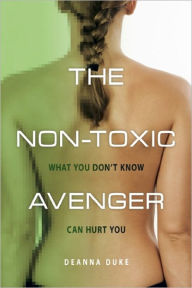I’ve been lecturing this week about human exposure to chemicals such as phthalates and mercury, so I thought I’d repost this review of a related book – enjoy! Be sure to “like” greenmomster on facebook!

The Non-Toxic Avenger, by Deanna Duke, is the fascinating story of one woman’s attempt to find out how significant our exposure is to “everyday” toxins. Spurred on by her husband’s diagnosis with multiple myeloma and her son’s diagnosis with Asperger’s syndrome, Deanna Duke decided to take a look at toxins and determine whether it’s possible, or even desirable, to remove every toxin exposure from one’s everyday life.
The author begins by discussing the reasons for this project – her husband and son’s diagnoses, and her newly acquired knowledge that many chemicals which she believed were regulated by government agencies were not. Her plan for the project is pretty simple. She’ll get tested (both blood and urine tests) for specific chemicals found in our man-made environment, try to remove as many toxin exposures as possible over several months, and then get retested. The first question is, does her daily life lead to any abnormally high toxic loads? The second question is, can she reduce these loads by reducing exposure? The third question is, can she live with the changes necessary to reduce the toxins?
The author leaves no stone unturned as she addresses the very high levels of various phthalates and parabens in her system. She looks at exposures from food, indoor and outdoor air, clothing coatings (to reduce flammability), all the way to yoga mats, hula hoops, and Halloween costumes. Did she succeed in reducing her exposure? You’ll have to read the book to find out!
The book is well-written with many humorous anecdotes. Ms. Duke is definitely not anti-science and is willing to say when changes are simply not doable in her life. The information on the lack of regulation regarding various chemicals, and the differences between the European and U.S. regulations was quite informative. I must admit, I felt a little like a troll as I read about her attempts to find the right cosmetics and hair dyes (I’m obviously not keeping up in the beauty department). And there were definitely times when I wanted more numbers – Ms. Duke often states that exposure to various chemicals can lead to birth defects, nervous disorders, etc., but I wanted the numbers for the exposure levels. She does provide substantial footnoting for the reader desiring more detail.
The Non-Toxic Avenger is definitely worth reading – one woman’s adventure into reducing toxic loads. You’ll come away from this book much more conscious of your everyday choices, from soaps to shampoos even to Halloween costumes.
Anyone else read any interesting environmental books lately?






